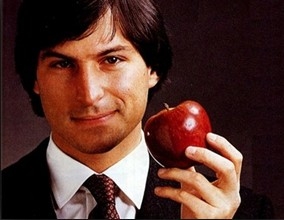The improvements were in not just the details but the entire concept. The mouse at Xerox PARC could not be used to drag a window around the screen. Apple’s engineers devised an interface so you could not only drag windows and files around, you could even drop them into folders. The Xerox system required you to select a command in order to do anything, ranging from resizing a window to changing the extension that located a file. The Apple system transformed the desktop metaphor into virtual reality by allowing you to directly touch, manipulate, drag, and relocate things. And Apple’s engineers worked in tandem with its designers—with Jobs spurring them on daily—to improve the desktop concept by adding delightful icons and menus that pulled down from a bar atop each window and the capability to open files and folders with a double click.
得到提升的并不僅僅是細節,還有整個概念。施樂PARC的鼠標并不能用來在屏幕上拖拽窗口。而蘋果工程師們設計出的界面上,用戶不僅可以任意拖拽窗口和文件,還可以將它們拖到文件夾中。施樂的系統中,不管是調整窗口的大小還是更改文件的擴展名,用戶都必須選擇一條指令后才能執行操作。蘋果的系統將桌面的概念轉化為了虛擬現實,允許用戶直接觸摸、操作、拖拽和移動文件。蘋果的工程師和設計師每天都受到喬布斯的鞭策。他們協同工作,完善了桌面概念:添加了漂亮的圖標和位于窗口頂端的下拉菜單,以及雙擊鼠標打開文件和文件夾的功能。
It’s not as if Xerox executives ignored what their scientists had created at PARC. In fact they did try to capitalize on it, and in the process they showed why good execution is as important as good ideas. In 1981, well before the Apple Lisa or Macintosh, they introduced the Xerox Star, a machine that featured their graphical user interface, mouse, bitmapped display, windows, and desktop metaphor. But it was clunky (it could take minutes to save a large file), costly ($16,595 at retail stores), and aimed mainly at the networked office market. It flopped; only thirty thousand were ever sold.
施樂的管理層并沒有忽略他們的科學家在帕克創造出來的東西。事實上,他們的確嘗試過利用這些研究成果——而這一過程恰恰證明了為什么好的執行力和杰出的創意同樣重要。在蘋果的麗薩和麥金塔電腦問世之前,早在1981年,施樂就推出了他們的“施樂之星”(XeroxStar),這臺電腦上運用了圖形用戶界面、鼠標、位圖顯示、窗口以及桌面概念。但它運行緩慢(保存稍大一點兒的文件需要耗費數分鐘),價格昂貴(零售價高達16595美元),且主要瞄準的是計算機網絡化的企業市場。它的銷售情況十分不好,僅僅賣出去3萬臺。
Jobs and his team went to a Xerox dealer to look at the Star as soon as it was released. But he deemed it so worthless that he told his colleagues they couldn’t spend the money to buy one. “We were very relieved,” he recalled. “We knew they hadn’t done it right, and that we could—at a fraction of the price.” A few weeks later he called Bob Belleville, one of the hardware designers on the Xerox Star team. “Everything you’ve ever done in your life is shit,” Jobs said, “so why don’t you come work for me?” Belleville did, and so did Larry Tesler.
施樂之星剛剛發布,喬布斯和他的團隊就去一家施樂經銷商那里查看情況。但他覺得這臺機器毫無價值,他告訴同事們根本犯不著花錢買一臺。“我們都松了一口氣,”他回憶說,“我們看得出來,施樂沒能把產品做好,但我們可以,而且價格要便宜得多。”幾個星期之后,喬布斯給施樂之星團隊的硬件設計師之一鮑勃·貝爾維爾(BobBelleville)去了電話。“你這一輩子做出來的東西都是垃圾,”喬布斯說,“干脆來為我工作吧。”貝爾維爾同意了,一起跳槽的還有拉里·特斯勒。
In his excitement, Jobs began to take over the daily management of the Lisa project, which was being run by John Couch, the former HP engineer. Ignoring Couch, he dealt directly with Atkinson and Tesler to insert his own ideas, especially on Lisa’s graphical interface design. “He would call me at all hours, 2 a.m. or 5 a.m.,” said Tesler. “I loved it. But it upset my bosses at the Lisa division.” Jobs was told to stop making out-of-channel calls. He held himself back for a while, but not for long.
喬布斯十分興奮,開始插手麗薩項目的日常管理,該項目當時的負責人是曾經的惠普工程師約翰·庫奇。喬布斯完全忽略了庫奇的存在,直接與阿特金森和特斯勒通氣,灌輸自己的想法,尤其是關于麗薩的圖形界面設計。“他會在任何時間給我打電話,凌晨兩點或者早上5點,”特斯勒說,“我喜歡這樣。但是麗薩項目的頭兒們不高興了。”喬布斯被要求停止越級管理。他安靜了一段時間,但很快又按捺不住了。
One important showdown occurred when Atkinson decided that the screen should have a white background rather than a dark one. This would allow an attribute that both Atkinson and Jobs wanted: WYSIWYG, pronounced “wiz-ee-wig,” an acronym for “What you see is what you get.” What you saw on the screen was what you’d get when you printed it out. “The hardware team screamed bloody murder,” Atkinson recalled. “They said it would force us to use a phosphor that was a lot less persistent and would flicker more.” So Atkinson enlisted Jobs, who came down on his side. The hardware folks grumbled, but then went off and figured it out. “Steve wasn’t much of an engineer himself, but he was very good at assessing people’s answers. He could tell whether the engineers were defensive or unsure of themselves.”
阿特金森認為應該把屏幕的深色背景換成白色的,這引發了一次重大沖突。屏幕背景色的改變可以實現阿特金森和喬布斯都想要的一個特性:WYSIWYG,這是“所見即所得”(WhatYouSeeIsWhatYouGet)的縮寫。你在屏幕上看到的是什么樣,打印出來就還是什么樣。“硬件團隊一片哀嚎,”阿特金森回憶說,“他們說,這樣的話就必須使用一種持久性差且閃爍嚴重的磷光體。”阿特金森只好搬來喬布斯幫忙,喬布斯自然站在了他的一邊。硬件團隊抱怨連連,但之后還是實現了這個功能。“喬布斯本人算不上是個工程師,但他十分擅長評估別人的答案。他能看得出來工程師是心存戒備還是缺乏自信。”











